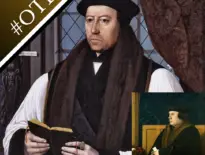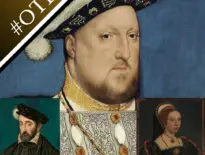On this day in Tudor history, 1st July, Sir Thomas More was tried and found guilty of treason; Parliament declared both of Henry VIII's daughters illegitimate; and the Treaties of Greenwich between England and Scotland were signed, and a marriage agreed between Prince Edward (Edward VI) and Mary, Queen of Scots...
- 1511 – Birth of Hadrianus Junius (Adriaen de Jonghe), physician, scholar, poet and historian, at Hoorn in the Netherlands. His contemporaries dubbed him as a “second Erasmus” and his works included “Philippeis” (1554), a poem celebrating the marriage of Mary I and Phlip II of Spain, and “The Batavia”, which was the first history of Holland.
- 1535 – The trial of Sir Thomas More began. He was tried by a special commission of oyer and terminer, and found guilty under the 1534 Treason Act for “traitorously attempting to deprive the King of his title of Supreme Head of the Church”. He was condemned to death. See video below.
- 1536 – Parliament declared that Henry VIII’s two daughters, Mary and Elizabeth, were illegitimate. This meant that the King had no legitimate children. See video below.
- 1543 - The Treaties of Greenwich were signed. In these treaties between England and Scotland, it was agreed that Prince Edward, the future Edward VI, would marry Mary, Queen of Scots. See video below.
- 1555 – Execution of John Bradford, evangelical preacher and martyr, at Smithfield. Bradford was burned at the stake after being condemned as a heretic. He was influenced by his friend, Martin Bucer.
- 1572 – Death of John Clement, physician, in exile in Louvain. He was buried near the high altar of the cathedral church of St Rumbold. Clement started his career as tutor to Thomas More's children before moving into the service of Cardinal Wolsey, who sent him to be educated at Corpus Christi College, Oxford. He also studied medicine at Louvain and in Italy. On his return to England, he joined More's household and married More's adopted daughter, Margaret Giggs, before becoming a Court Physician. Clement was imprisoned in the Tower of London in 1535, along with More, for refusing to take the “Oath of Supremacy”. He was eventually released, and in 1544 became President of the College of Physicians. Clement was forced into exile in the reign of the Protestant Edward VI and Elizabeth I.
- 1582 – Death of John Harington, courtier, scholar and poet, at Stepney, London. He was buried beside his second wife, Isabell, in the church of St Gregory by Paul, London. Some of his poems can be found in the 1557 “Tottel's Songes and Sonettes”. Harington served Henry VIII and Sir Thomas Seymour, and was close enough to Elizabeth I for her to stand as godmother to his son, John, in 1560.
- 1591 – Execution of Catholic priest and martyr George Beesley in Fleet Street London. He was hanged, drawn and quartered with Montford Scott, another Catholic priest. He was condemned to death by the statute which made being a Catholic missionary priest treason in the reign of Elizabeth I. While he was imprisoned in the Martin Tower at the Tower of London, Beesley carved his name on the wall of his cell, an inscription which can still be seen today.
- 1614 – Death of Isaac Casaubon, classical scholar and ecclesiastical historian, in Drury Lane, London. He was buried in Westminster Abbey. His first major work was a commentary on the work of Strabo, the Greek geographer.
- 1622 – Death of William Parker, 13th Baron Morley and the man who discovered the Gunpowder Plot. He died in his Essex home at Great Hallingbury.



Leave a Reply